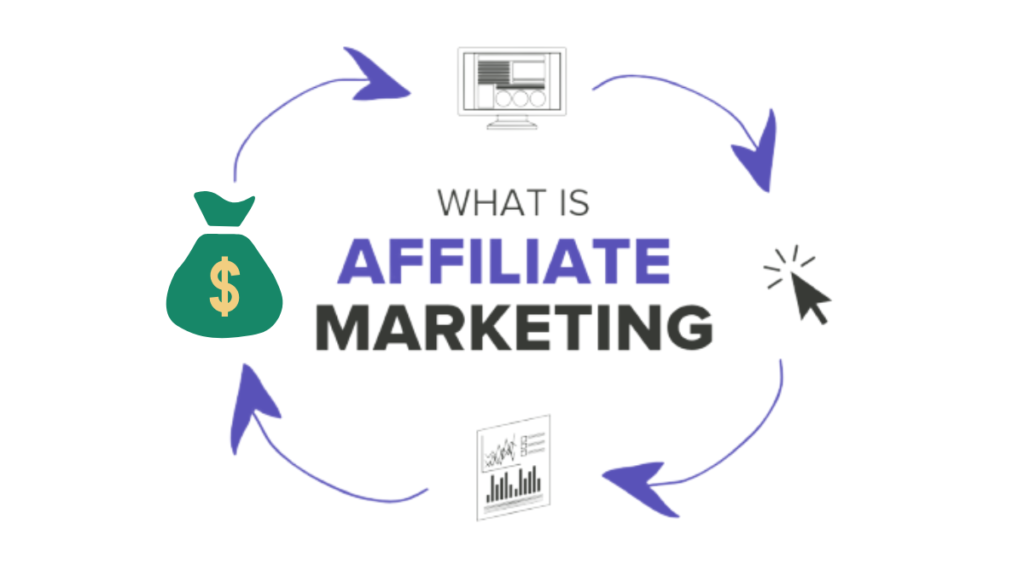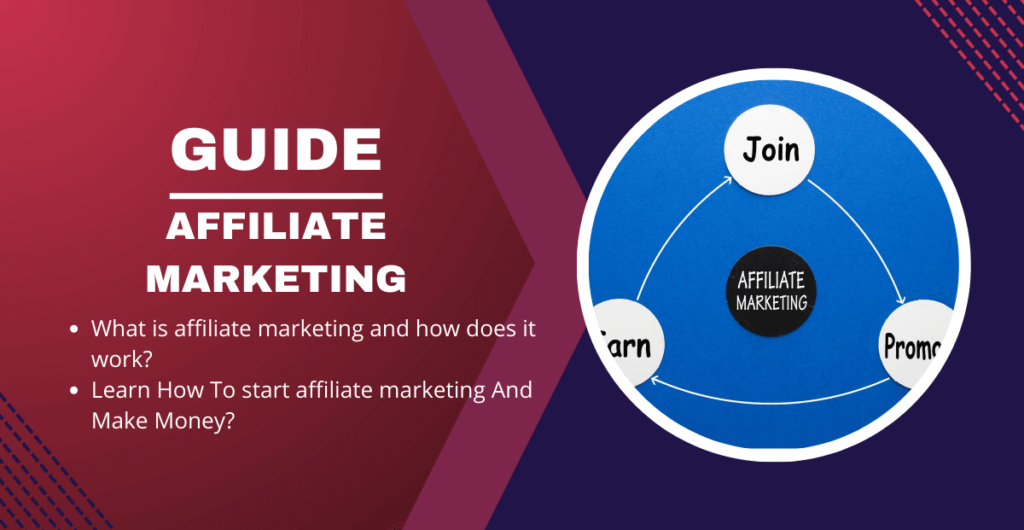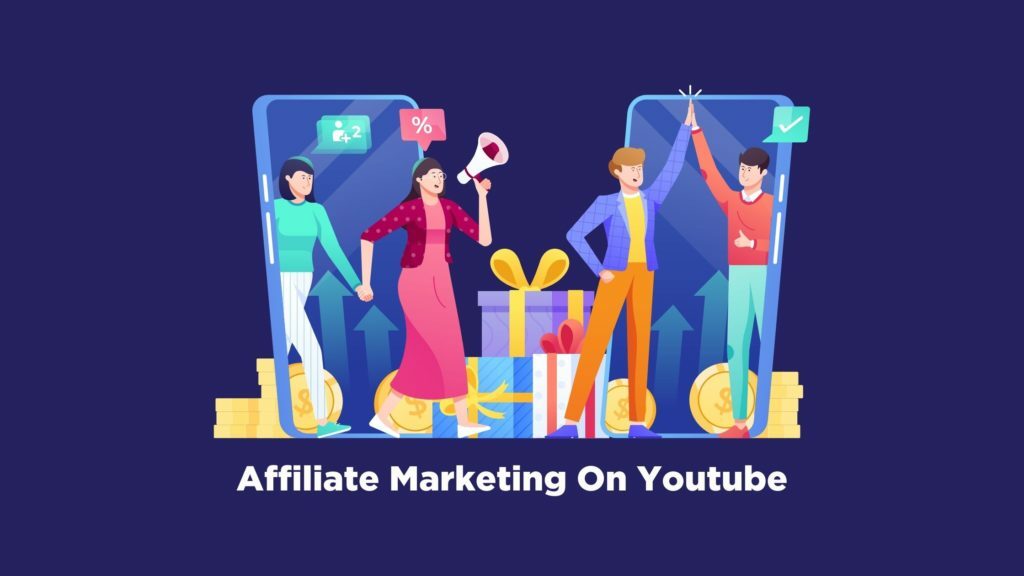Affiliate marketing is about earning income (commissions) every time you promote a company’s products or services and make a sale. You only get paid if you make a sale, just like a commissioned sales representative.
Affiliate marketers make much money by adding affiliate links to their content. This affiliate marketing examples Blog of Adam Enfroy earns an average monthly income of five figures (Adam enfroy net worth).
While not everyone earns a six-figure salary from affiliate marketing, there are tips and strategies you can use to improve your site and increase your income.
Start a blog or create a website, add affiliate links, and earn passive income like you’ve always wanted. Sounds ideal.
Blogging is not the only way to make money with affiliate marketing. Microsites, email lists and video marketing are just a few methods to generate income online.
Are you ready to learn more about what is affiliate marketing? And how does It work? This guide on affiliate marketing for beginners answers all the questions you may have on the subject.
What is Affiliate Marketing?

Affiliate marketing promotes other people’s products in exchange for a small commission for each sale.
You’ve probably seen sections labelled “affiliate link” or “sponsored article” on many of the websites you visit, or perhaps you’ve already taken the first step by signing up for an affiliate network.
If affiliate marketing is new to you, let’s look at how it works.
First, find an affiliate program or network that interests you. Look at the program’s presentation, including the type of products or services, payment methods and commissions offered.
If interested in the program, sign up and await acceptance confirmation. Then start creating affiliate marketing content, adding the custom links provided by the program. These links let you track and know if anyone makes a purchase, so you earn a commission.
You can work with individual Brands or affiliate platforms, where you sign up and choose the programs that interest you. Programs are usually divided into categories for easy selection.
After being approved as an affiliate partner, you only have to promote its links on your website, in newsletters, on social media and in any other place.
The network sends you a payment when you reach the minimum payment level. Payment methods vary but generally include PayPal, bank transfers and bank checks.
4 elements of an effective affiliate marketing business
Let’s take a closer look at the elements of an effective affiliate marketing system.
1. The Seller
Also known as the creator, supplier, brand, retailer or merchant. It is the person who creates the product. It can be a big company, such as Samsung or Appl, which are smartphone manufacturers.
It can also be a single person selling online courses on Udemy or Fiverr.
Whether they are independent contractors, start-ups or large top-ranked companies, anyone can be the merchant behind an affiliate marketing program.
They don’t even have to be actively involved. The only thing they need is a vendable product to sell.
2. The Affiliate (Partner)
This part is sometimes also called the publisher. Affiliates can be single individuals or entire companies.
An affiliate marketing business can generate a few hundred dollars in monthly commissions or tens of millions.
An affiliate promotes one or more products and tries to attract and convince potential customers of the value of the marketer’s product so they eventually buy it.
3. The Consumer (Buyer)
The customer or consumer drives the affiliate system. Without sales, there is no commission to distribute and no revenue to share.
The affiliate will reach the consumer through whatever channel they feel is most appropriate, whether it’s a social network, digital billboards or a search engine using content marketing on a blog.
The consumer must know they are part of an affiliate marketing system. Typically, a brief warning such as:
“If you purchase items from this site, I may receive a small commission. Thank you for supporting our work” is sufficient.
The consumer will usually not pay a higher price to the affiliate marketer because the cost of the affiliate network is already included in the retail price.
4. The Affiliate Platform (Affiliate Network)
Only some people consider the network part of the affiliate marketing equation. However, a guide to affiliate marketing should include networks because, in many cases, a network serves as an intermediary between the affiliate and the merchant.
While you can technically promote someone else’s course and agree to a direct revenue share with them, letting a network such as Shareasale or Commission Junction handle payment and product delivery lends a more serious note to your affiliate marketing.
Sometimes affiliates must go through an affiliate network to promote the product. For example, if the merchant only runs his affiliate program on this network.
The affiliate network also serves as a database for many products, from which the affiliate marketer can choose the ones he wants to promote.
In the case of promoting consumer products, such as tools, books, toys and household items, the largest affiliate network by far is Amazon.
Anyone can sign up and create an affiliate link to products on Amazon. When someone purchases the product through your link., you get a commission.
Benefits of Affiliate Marketing
Affiliate marketing offers numerous benefits for individuals or businesses looking to monetize their online presence. Some of the key benefits include:
- Passive Income: Affiliate marketing is about earning money even when not promoting products. Once you've set up your affiliate campaigns, you can earn passive income if your referrals continue to make purchases.
- Low Startup Costs: Affiliate marketing has relatively low startup costs compared to other online business models. You don't need to create your product, invest in inventory, or handle customer support, which makes it an affordable option for beginners.
- Flexibility: Affiliate marketing offers flexibility in terms of when and where you work. You can choose your schedule, work from anywhere with an internet connection, and scale your business at your own pace.
- Diverse Income Streams: With affiliate marketing, you can promote products from multiple companies, diversifying your income streams. It reduces the risk of relying on a single product or company for earnings.
- No Customer Support:As an affiliate, you can handle customer support without having to handle customer support. Once a referral makes a purchase, the responsibility of order fulfilment, shipping, and customer service lies with the company whose product you're promoting.
Mistakes To Avoid as an Affiliate Marketer?
While affiliate marketing is successful for many people, it can also have a dark side.
Like any online activity that involves making money, affiliate marketing is a target for various types of fraud, such as cookie stuffing and embezzlement.
Other practices to avoid include:
- Creating low-quality content: Gone are the days when you could produce keyword-laden content and dominate Google. Instead, write quality content and add value to each article.
- Use the “Aggressive Selling” approach: Focus on building relationships rather than a direct sales approach. Customers who trust you are more likely to buy what you recommend.
- Not checking product legitimacy: That health product may look impressive and bring in high commissions, but does it do what it claims? Choose your products carefully and read online reviews.
- Misleading buyers: It goes without saying, but the lure of commissions can cause some affiliates to misrepresent product benefits. Making bold claims can get you more clicks, but it's unethical and illegal.
As an affiliate marketer, your reputation is critical. You won't earn any revenue if your audience distrusts or believes you. Focus on your audience first and foremost.
How To Start Your Affiliate Marketing Business?
After clarifying the basic terms, let's look at how you can start building your affiliate marketing business.
As I said, there are two sides to the affiliate marketing equation to choose from, assuming you will not build an affiliate network like Commission Junction.
You can become a marketer and have others promote your product in exchange for a commission on their sales.
It is also possible to affiliate with several products and market them to potential buyers to earn additional income.
While most people start by going the affiliate route, which is certainly the easiest route, it is neither quick nor easy to create enough traffic to earn a significant income from affiliate sales alone.
That's why I will explain the four basic steps you need to take to get started in both areas of affiliate marketing.
How To Become An Affiliate Seller?
Here are the steps to follow to become an affiliate seller and make money by having affiliates sell your product.
- To start, you need to have a product idea. I'll show you in the next section some ways to generate these ideas based on what is already popular.
- Next, you need to validate your idea. You could go ahead and build your idea. What if people don't want it? An idea is only good if people want it to happen.
- Finally, you need to create the product. Since creating a physical product comes with significant investment and risk, it's best to start by creating digital products.
These are the best ways to get started, as they usually only require time and little to no money.
Also, once your product is created and launched, you must find affiliates to promote it – affiliate marketing networks can help.
How To Become An Online Affiliate Marketer?
There are four steps to follow, similar to starting an affiliate company.
- First, start reviewing products in your niche. Do this through a blog, YouTube channel, or live stream on Periscope.
- Second, you need to collect emails to connect with your audience at any time and not have to hope they see your content.
- Third, you can use JV webinars to make many sales quickly while growing your email list and creating new content.
- Finally, when your affiliate marketing business starts to make money, you can expand your growth with pay-per-click advertising.
7 Ways To Start An Affiliate Marketing Business
In addition to the traditional methods of promoting affiliate marketing links, there have been some significant new trends in recent years.
The following section examines some of these trends and the more traditional affiliate link promotion methods.
1. Starting A Blog
Affiliate marketing is often the preferred choice for bloggers who want to monetize their content.
Bloggers usually specialize in a specific niche and share products or services that interest their audience. Examples include customer management systems, health trackers or credit cards.
This affiliate program works well with niche businesses, and the more you specialize, the better.
To deploy affiliate marketing on your blog, insert links into blog posts, or add banners, video clips, or even pop-ups. Social networks and emails can also help you share your links.
However, links should only be included when natural and should be reasonable. If you have a newsletter, distribute your links through promotions, gift codes and product comparisons.
Finally, focus on sharing useful links and offering value to your subscribers. Avoid just selling – make sure you offer some value first.
To start your affiliate marketing business with a blog, check out my article on the best blogging platforms.
2. Create And Share Videos
Video content is not only popular, but people also love it. Just look at YouTube and its 2.681 billion active users in 2022.
Other social media platforms perfect for sharing video content include Instagram, TikTok, and Facebook.
The content that busy people easily consume video is perfect for showing people how to Guide them in using a product, how it is beneficial to them, and pointing out the advantages and disadvantages.
The usual best practice is to add affiliate products, pin them below the video on YouTube, add them to your bio and be active on your community page.
Please read my guide to getting started with affiliate marketing on youtube.
Consider using this approach to inspire confidence in your consumers and if video demos help illustrate the benefits of your product.
3. Advertising Via Social Networks
It is possible to advertise on Facebook and other social networks, but you need to make sure your ads follow the guidelines outlined by each specific network.
Posting and sharing your affiliate content on social media sites such as Facebook can be ideal for affiliate marketers with many followers or a niche product.
Here are some ways to share your links:
- Facebook ads
- Tik Tok Ads
- personal pages
- groups
- promotional messages
4. Recruiting An Influencer
Influencers are one of the main faces of affiliate marketing today, thanks to social media and sites like YouTube.
However, many ordinary people have become famous solely because of their influencer status and ability to create engaging content and interact with their audience.
Brands pay influencers to promote their products, so sharing affiliate links with their followers in exchange for commissions makes sense.
If you are a business with a large or passionate audience, consider influencer marketing.
As an example, on Instagram, you can share and promote your links by:
- Tag the brand when you promote their product.
- Include links in your Instagram Bio.
- Use Instagram Stories and IGTV stories to talk about products and promote them.
- Providing helpful comparisons of products and gifting guides for educating your audience.
- As you add links, include a strong CTA encouraging followers to like and share on Instagram.
One last tip: choose products that make sense for your brand or niche, and only share products you love. Your audience needs to believe that you have their best interests in mind.
5. Affiliate Links
When you sign up for an affiliate marketing platform, you can access a personalized referral link. When a visitor to your blog, newsletter, Facebook page, or other social network clicks on this link and makes a purchase, you will be paid a commission.
For example, BigCommerce's affiliate program pays very well: it offers $1,500 for every business referred.
This strategy suits businesses that send regular newsletters or write blogs or reviews. However, you can also use affiliate links in the:
- articles/tutorials
- resource pages
- some forums
- banners and video content
- blog posts
However you use affiliate links, make sure your content is useful and that your links are contextual and visible.
When sending content to new subscribers, focus on building customer relationships and trust before adding links.
NB: With social media, it's not a good idea to share affiliate links directly, but share links to your published content with affiliate links. Use affiliate link-tracking softwares as a link shortener.
Ultimately, pay attention to the basic rules of creating content for affiliate articles, such as using keywords, direct access instructions and catchy headlines.
6. Creating Microsites Websites (Micro Niches)
Micro or mini-sites are separate from a main website and are often used to target specific audiences.
Brands can use them alongside other marketing efforts, such as blogs or social media.
The format of a microsite varies from a single page to promote specific products or services to a collection of pages. It can have its domain or be a subdomain of the main domain.
In general, brands use microsites to highlight something specific.
It can be:
- particular events
- products, campaigns
- content/branded content
However, brands are just some of the ones using micro-sites. Regular affiliates create them too. The relevance of microsites depends on several factors, such as
- The role in your customer journey.
- Whether you need to maintain the site long-term.
- If you are testing campaigns or keywords.
- If you are an affiliate targeting a specific niche.
To improve your chances of success with micro-sites, be sure to:
- Write information-rich and media-rich content.
- Highlight features and benefits so visitors can read the content at a glance.
- Incorporate various content to suit visitors' preferences – for example, videos or Gifs.
- Provide reviews of products you've tried and tested – and be honest.
- Combine products from different affiliate programs for a complete mix and offer different products at different price points.
7. Newsletters – Email Lists
Affiliate marketing newsletters are another popular way to share affiliate links with your audience.
For example, HubSpot uses this strategy to promote its products and affiliate programs.
Marketers build email lists of their registered users through Email marketing services providers such as ConvertKit and Getresponse.
Usually, they offer an incentive to sign up, such as a free training session, templates or an eBook.
Newsletters often contain affiliate links, which allow the marketer to earn money when a subscriber clicks on a link and makes a purchase.
Marketers with an existing email list and committed subscribers can benefit from this affiliate link promotion, regardless of their niche.
This method is suitable when you already have a list or share valuable content with your audience, such as training and tips. Time-limited and exclusive offers from affiliate programs are also effective.
How To Track Affiliate Marketing Success?
What's the best way to know if your marketing efforts are effective? Tracking your affiliate links indicators.
Start with your affiliate program's dashboard and see what it tells you. Affiliates who use advertising programs like Google, Facebook or Amazon can also use their dashboards to track statistics for each channel.
There are also affiliate marketing tools that track performance, gather analytics and provide competitive data.
Here are the top affiliate metrics to pay attention to:
- number of clicks
- ad spend
- ROI
- conversion rate
- net monthly sales
- overall revenue.
These metrics will tell you how often people click on your links and how often they buy. Pay attention to the type of content that is most effective in driving sales and create more of that content.
How To Choose The Best Affiliate Marketing Strategy For Your Business?
Affiliate marketing is a viable monetization method for any business, but the success of your campaign depends on choosing the right strategy. Below is how to choose the right affiliate marketing strategy for your business.
- Ensure the strategy is appropriate for your audience: Do these people frequent social networks? Forums? Are they searching for answers on Google? Know where your potential customers are and target them there.
- Understand the type of content your audience responds to: What makes them click to learn more or subscribe to a product? What offers work best for your particular audience? Are they gifts? Contests? Discounts? The right offers can make or break your affiliate marketing campaigns.
- Use A/B testing tools: Compare results and use this data to refine your affiliate marketing strategy.
- Understand your customers’ pain points: Address these issues with detailed content and relevant products.
How to Get Started with Affiliate Marketing
Getting started with affiliate marketing involves a few key steps:
- Choose a Niche: Select a niche you're passionate about or know about. Creating valuable content and connecting with your target audience is easier.
- Research Affiliate Programs: Find affiliate programs that align with your niche and offer competitive commission rates. Look for programs that provide reliable tracking and payment systems.
- Build a Website: Create a professional-looking website or blog that showcases your niche and promotes affiliate products. Ensure your website is user-friendly, responsive, and optimized for search engines.
- Create Valuable Content: Create high-quality, engaging, and informative content that provides value to your audience. It can include product reviews, tutorials, comparisons, and other types of content that help your audience make informed purchasing decisions.
Finding Profitable Affiliate Programs
Finding profitable affiliate programs is crucial for your success in affiliate marketing. Here are some tips to help you find the right affiliate programs for your niche:
- Research Affiliate Networks: Sign up for reputable affiliate networks like Amazon Associates, Commission Junction, ShareASale, and ClickBank. These platforms offer a lot of products and services to promote, making it easier to find profitable affiliate programs.
- Explore Niche-Specific Programs: Look for affiliate programs specifically tailored to your niche. For example, if your niche is fitness, look for fitness-related affiliate programs such as fitness equipment, supplements, or online fitness programs.
- Consider Commission Rates: Compare commission rates among different affiliate programs. Look for programs that offer competitive commission rates and have a good reputation for timely and accurate payments.
- Check Product Quality and Reputation: Before promoting a product, ensure it is of high quality and has a good reputation. Research customer reviews, ratings, and feedback to ensure that the product meets the needs and expectations of your audience.
Creating High-Converting Affiliate Content
Creating high-converting content is essential for driving traffic and generating sales through your affiliate links. Here are some tips for creating effective affiliate content:
- Know Your Audience: Understand the needs, interests, and preferences of your target audience. Produce content that touches them and addresses their concerns.
- Be Genuine and Authentic: Authenticity is key in affiliate marketing. Avoid using overly salesy language or making exaggerated claims. Be genuine and transparent about your experiences with the products you promote.
- Use Visuals: Incorporate visuals such as images, videos, and infographics in your content to make it more engaging and shareable. Visuals can help illustrate the benefits of the product and persuade your audience to take action.
- Call-to-Action: Include clear and compelling call-to-action (CTA) in your content, guiding your audience to take the desired action, such as clicking on your affiliate link or making a purchase.
Implementing SEO Strategies for Affiliate Marketing
Implementing SEO (Search Engine Optimization) strategies is crucial for driving organic traffic to your affiliate content. Here are some SEO tips for affiliate marketing success:
- Keyword Research: Conduct extensive keyword research to identify top keywords related to your niche and strategically incorporate them into your content, including your titles, headings and overall body copy.
- Meta Tag Optimization: Improve your meta tags, including the title and meta descriptions, to make them relevant and attractive to search engines and users. That can improve your click-through rate (CTR) and increase traffic to your content.
- Quality Backlink Building: Build high-quality backlinks from reputable websites to increase the authority and visibility of your content. You can do this through guest blogging, outreach and creating shareable content that other websites want to link to.
- Improve site speed: Consider optimizing your website's loading speed to provide a better user experience and reduce bounce rate. Use Google PageSpeed Insights to identify and address speed issues on your website.
Maximizing Conversions with Email Marketing
A powerful tool in affiliate marketing is Email marketing. Here are some tips for maximizing conversions with email marketing:
- Start an email list: Build a list of subscribers interested in your niche and products. Offer valuable content or incentives to encourage visitors to sign up for your email list.
- Subsegment your list: Segment your email list based on various criteria, such as interests, preferences and buying behaviour. Doing so enables you to send targeted, personalized emails that are more likely to convert customers.
- Creating engaging emails: Create attractive and engaging emails that provide value to your subscribers. Include relevant affiliate products and use persuasive language to encourage them to click on your affiliate links.
- Analyze and optimize: Test and optimize your email campaigns to improve open, click and conversion rates. Experiment with different subject lines, email formats and calls to action to find what works best for your audience.
Analyzing and Optimizing Your Affiliate Marketing Performance
Analyzing and optimizing your affiliate marketing performance is crucial to identify what works and doesn't. Here are some tips for analyzing and optimizing your performance:
- Benchmark it: Use tracking tools to measure the performance of your affiliate marketing campaigns. Monitor metrics such as traffic, clicks, conversions and revenue to determine what's working and what needs to be improved.
- Identify High-Performing Strategies: Identify the strategies driving the most traffic and conversions for your affiliate marketing efforts. Double down on these strategies and allocate more resources for optimal results.
- Experiment with New Strategies: Continuously experiment with new strategies to expand your reach and find new sources of traffic and conversions. Test platforms, content formats, and promotional tactics to uncover new opportunities.
- Optimize your content: Regularly update and optimize your content based on performance data and user feedback. That could mean changing your headlines, improving your calls to action, or updating outdated information to keep your content fresh and relevant.
FAQs
Q: How long does it take to see results in affiliate marketing?
A: The timeline for seeing results in affiliate marketing can vary depending on factors such as your niche, content quality, SEO efforts, and promotional strategies. Some affiliates may start seeing results within a few months, while others may take longer.
Q: Do I need a website to start affiliate marketing?
A: While having a website can benefit affiliate marketing, it is only sometimes necessary. You can promote affiliate products through social media, email marketing, or other platforms. However, having a website gives you more control and flexibility over your content and promotions.
Q: How much money can I make with affiliate marketing?
A: The earning potential in affiliate marketing is limitless and varies depending on your efforts, strategies, and the niche you are in. Some affiliates earn a few hundred dollars monthly, while others can earn six-figure incomes or more.
Q: Is it important to disclose affiliate links in my content?
A: Yes, it is important to disclose affiliate links in your content to comply with Federal Trade Commission (FTC) guidelines and maintain transparency with your audience. Disclosing affiliate links helps build trust with your audience and ensures they know your affiliate marketing efforts.
Q: Can I promote multiple affiliate programs at the same time?
A: Yes, you can promote multiple affiliate programs simultaneously. However, ensuring that the products and services you promote align with your niche and target audience to maintain relevance and credibility is important.
Q: How can I increase my affiliate marketing conversions?
A: There are several ways to increase your affiliate marketing conversions. Some tips include creating high-quality content, optimizing your website for SEO, leveraging social media, utilizing email marketing services, and continuously analyzing and optimizing your performance to improve conversion rates.
Q: Is it necessary to have a large following on social media to succeed in affiliate marketing?
A: While having a large following on social media can be beneficial for affiliate marketing, it can be optional. You can still succeed by creating engaging content, building a loyal audience, and leveraging targeted strategies to promote your affiliate products.
Q: What are some common mistakes to avoid in affiliate marketing?
A: Some common mistakes to avoid in affiliate marketing include promoting low-quality products, neglecting SEO strategies, spamming your audience with excessive promotions, not disclosing affiliate links, and not analyzing and optimizing your performance regularly.
Q: Can I do affiliate marketing part-time while having a full-time job?
A: Yes, you can do affiliate marketing part-time while working full-time. Many affiliates start as a side hustle and gradually transition to full-time as their income grows. It requires dedication, time management, and consistent efforts to balance responsibilities effectively.
Conclusion
Affiliate marketing can be both profitable and fulfilling when done right. By applying the tips and strategies outlined in this guide, you can set yourself up for success in affiliate marketing.
Remember to build a strong foundation, create high-quality content, implement SEO strategies, leverage social media, utilise email marketing, and continuously analyse and optimise your performance.
With dedication, perseverance, and strategic execution, you can succeed as an affiliate marketer and reap the rewards of your efforts.
As times change, affiliate marketing is evolving. Previously, blogs and email lists were the primary means of sharing affiliate links, but today social media allows influencers to earn significant income by promoting affiliate products.
Whichever method you choose, ensure the products you share are relevant to your audience and avoid questionable practices.
Do you use affiliate marketing? Which strategies work best for you?





